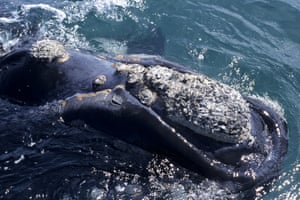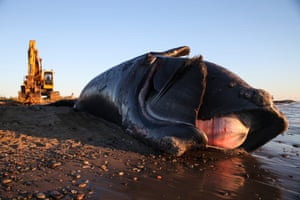“You can’t work on North Atlantic right whales and be a pessimist,” Clay George tells me. He’s a senior wildlife biologist and right whale specialist at Georgia’s department of natural resources, and one of the only people in the south formally trained to disentangle a whale from fishing gear.
Right whales are known to spend most of their time near the surface of the water, feeding and socializing. This behavior leaves them vulnerable to boat strikes and entanglement in fishing lines, almost exclusively the cause of their deaths.
There are so few North Atlantic right whales left in the world’s oceans – estimates hover around 400 – that many are known entities to the scientists who devote their careers to saving them. They often identify them by the patterns of callosity on their heads, raised tissue colored white by an infestation of cyamids, commonly known as “whale lice”.
I want to know if George feels any optimism at the slight uptick in calving in 2020, as 10 were seen in calving grounds this winter. There were zero calves recorded in 2018, and according to Woods Hole Oceanographic Institution, calving has been down 40% since 2010.
“People always focus on the calves,” George says. “But what really matters is protecting the females of reproductive age. There are only 100 left, and at their current calving rates, they aren’t replacing themselves, or the number of right whales killed each year by human activity.” The females need to have an estimated 17-20 calves total each year to sustain the population.
I mention Dragon, a 19-year-old female right whale spotted this year off the coast of Nantucket with a fishing buoy entangled in her mouth, dying. George pauses. “I remember when she had her first calf,” he says.
“You know, it’s not a quick death,” George adds. “They suffer out there, entangled and not able to feed. It’s long and painful.”

George has watched whales struggle to survive horrendous ship strike injuries. He’s seen fishing rope embedded in the whales’ faces, cutting through bones, entire lips pulled off.
One of his favorite whales is Ruffian, whom he first spotted with chunks of blubber missing after a ship strike. “We assumed he was a goner,” George says. “But he came back the next season, scarred.” Ruffian returned to Georgia waters another time, snow crab cables trailing behind him.
“Eighty per cent of right whales have scars,” George tells me. “And 60% have been entangled twice. People would be shocked.”
An intelligent, gentle giant
Right whales were once hunted to near-extinction by whalers. They were known as the “right” and easy whale to hunt – docile, slow-swimming and huge – 52 feet long and sometimes weighing in just under 70 tons.
Often referred to as the “urban whale”, North Atlantic right whales spend most of their year feeding close to the shorelines of New England and Atlantic Canada. Each winter pregnant females and other members of the species migrate 1,000 miles south to Georgia and Florida, the species’ only known calving grounds. Their coastal distribution places them in close proximity to large population centers, and all the human activities that go with that, from commercial fishing and shipping, to pollution and military training.
No one really knows how long North Atlantic right whales can live, because human activity has affected their life spans so drastically. Experts presume they can live until 65 or 70, though some species of whale, like the bowhead, can live to 200. What we do know is that human activity has endangered this species and drastically shortened their lifespan to 35-40.

This year’s calving season of 10, while better than zero, is still not enough to sustain the species. Plus, one of the 10 calves was probably mortally injured in a boat strike in the first days of its life. Make that a calving season of nine – less than half of what the right whales need to replenish themselves.
Why is it so hard to save this intelligent, gentle giant – one so critical to the health of our planet? (Whale excrement fertilizes phytoplankton that produce a significant amount of oxygen on Earth.)
“A species that most people have never seen is harder to convince others to save,” says Dr Erica Fuller, a veterinarian and a lawyer with Conservation Law Foundation in Boston, Massachusetts. “If you saw one, you’d be struck by how majestic they are.”
Deadly entanglement
The whales are at risk any time fishing rope is left unattended in their habitat. But ropes used on offshore gillnets, lobster pots, snow crab pots and other so-called “fixed gear” fisheries are particularly problematic. These synthetic ropes can be set for weeks or months at a time, and require thousands of pounds of force to break loose from.
“Much of the frustration of the right whale work is the slowness at which agencies are taking action,” Fuller says. “Plus, the same federal agency charged with authorizing the commercial fisheries that entangle them is also in charge of protecting this critically endangered species. It’s a terrible conflict of interest.”
The real tragedy, according to Fuller, happened when the whales traveled into the Gulf of St Lawrence looking for food and, simultaneously, the snow crab fishery exploded. This shift was the perfect storm for entanglement, responsible for several deaths in 2017.
When I speak with Regina Asmutis-Silvia, executive director of Whale and Dolphin Conservation, she is quick to point out that no fishermen intend to catch whales. “They aren’t doing it on purpose,” she says. “We know they face hardships, too.”
Asmutis-Silvia, who has been working on these issues for 30 years, remembers seeing her first entangled whale: “You could see visible infections, and the whale was in a great deal of pain. The skin had grown over the line. For me, that’s when entanglement moved from a conceptual problem to a real one.”
There hasn’t yet been a broad fix to entanglement. “I think we’re closer with so-called ropeless fishing gear,” Asmutis-Silvia says. “It’s a costly transition, but it has tremendous potential. It’s the most promising solution I’ve seen.”

And then there’s the boat collisions. More than half of the known right whale population migrated into Cape Cod Bay in the summer of 2019, following their food source of phytoplankton. As they journey there and further northward toward Canada, they cross shipping lanes, putting them at risk of death by blunt force trauma and propeller cuts.
Research shows that slowing shipping speeds down from an average of 24 knots to 10 can help improve the odds for right whales, but several ships were fined by Transportation Canada for ignoring the warnings. The reduction in speed orders are lifted when no right whales are spotted, but detection mechanisms are faulty, and ship strikes have contributed to 30 deaths of right whales in the last three years.
The right whale calf born to Derecha that was struck this calving season – its head sliced by the propeller of a vessel – is presumed dead.
Noise pollution
“Trying to understand where the right whales are, and what their lives are like underwater, is difficult for humans,” Dr Genevieve Davis says. She’s an expert in passive acoustic monitoring, listening for whales as they pass through specific zones. Right whales are vocal – when socializing in “surface active groups” they scream, blow, gunshot, upcall, warble and downcall.
“People don’t think about noise pollution as a common threat, but it masks important communication cues,” Davis says. “A calf might not be able to find her mother. These whales need to navigate, find mates and locate food. There’s a masking effect that changes communication abilities.
“If you think about Massachusetts bays and New York harbors,” she says, “it’s like trying to talk on a phone in the city with sirens and traffic, versus talking on a phone in an empty field. That’s what their world is like now.”

This human-caused “acoustic smog” travels far, and is now constant in our ocean. It includes vessels, alternative energy sources and seismic surveys, which Davis says are so loud they can cause chronic stress and physical pain, like being next to the speakers at a loud concert.
Passive acoustic tracking is an important component of a suite of whale-tracking measures, including aerial surveys and reports from fishermen. Currently there is no reliable, compassionate way to track the right whales with GPS, which would theoretically help boat captains avoid ship strikes. Blubber and water make tagging difficult.
“No tagging method is really long-term,” Dr Davis says. “These whales are already endangered and many are in poor health – we don’t want to cause more suffering.”
“I look forward to the day when there aren’t more people working to save right whales than the actual number of whales themselves,” Asmutis-Silvia tells me. She recounts the time she spotted a right whale named Wart off the coast of Cape Cod, with a calf.
“There she was,” Asmutis-Silver says. “A tiny little shoehorn face with no callosity. The crazy thing is that Wart had been entangled several years prior. We thought she was dead – but here she comes back, free of gear, and gives birth in Cape Cod. It was incredible.”
“They’re so amazing – so resilient,” she adds. “These whales have such an ability to recover if we would only give them the chance.”
Climate change is already acting as a cruel catalyst, warming the whales’ habitat, causing currents to shift and altering the distribution of plankton the whales depend on. If these changes force the whales into new habitats with greater human activities but fewer protections, the results could be disastrous. This is exactly what appears to be happening in the Gulf of St Lawrence in Canada, where more than 20 right whales (5% of the existing population) have been found dead since 2017.
“Everything we think we know this summer could be different two summers from now,” Dr Fuller says.
“Watching right whales has been compared to watching the decline of vaquitas,” Dr Fuller tells me. “We’re watching the last ones die.”
“We’re responsible for the right whales’ demise,” she says, “and we are responsible for saving them from extinction.”
If you see a violation or injured animal, call the Northeast Marine Mammal and Sea Turtle Stranding and Entanglement Hotline: (866) 755-6622. If you’re a boater, download the Whale Alert app so you know when and where right whales are present – and slow down.